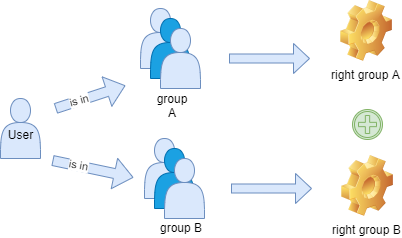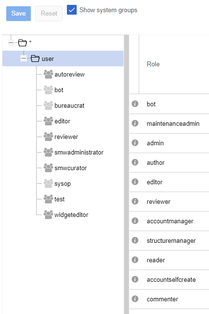Gebruikers aanmaken en toewijzen
-
- Laatst bewerkt 4 jaren geleden door Ilonka Du Pree
-
-
- Geen statusinformatie
Basics: The rights and roles concept of the wiki
The wiki uses groups and their roles to grant user permissions. To set the user permissions correctly, an understanding of this concept is a prerequisite. The starting point for the assignment of rights is not the individual user, but the user group, which is equipped with different roles and thus rights. The permissions add up when the user is in multiple groups.
The result is this scheme:

The following hierarchical standard groups and roles already exist in the wiki:
asterisk(*): each visitor of the wiki is automatically in this the group, because this is the group of anonymous users.
user: this is the default group of users who are logged in to the wiki - so they have an account and are logged in.
All other groups are on the same level and are hierarchically higher than the other two groups. They then already perform certain functions, e.g. editor (someone with write access) or sysop (an administrator with full privileges).
The roles in the column next to it contain sets of permissions. The roles are activated in the groups and thus the groups are provided with the permissions. Therefore, a user gets the permissions from the groups to which he or she belongs.
Creating a new user
Open the user manager in the Management menu of the navigation. Click on the "plus (+)" symbol and enter the required data. Select one or more groups to give the user the necessary permissions.
In this wiki, access without registration (without account) is not permitted. So the group * has no permission - also no read access. To enable your wiki users to interact with the wiki, they must be logged in. After logging in, a user is automatically in the group "user". A "user" can read, search, create and delete pages in the wiki - and, therefore, has editing access to wiki content. If you want new users to be able to manage the wiki, you must assign the group "Administrators".

